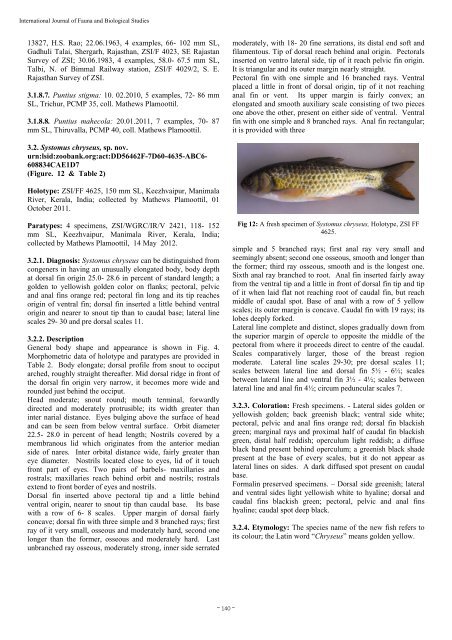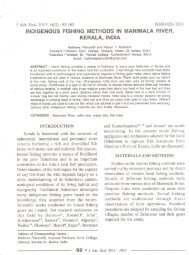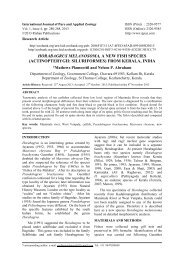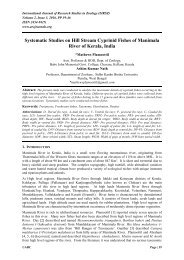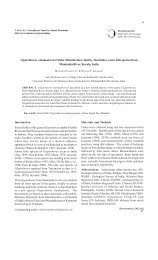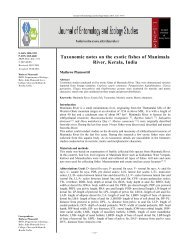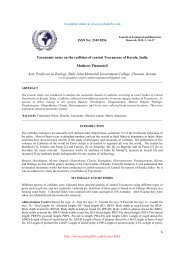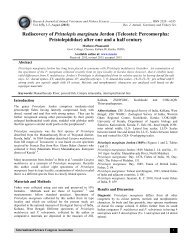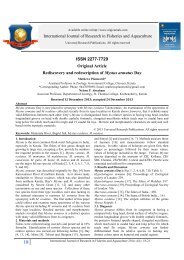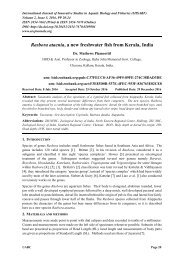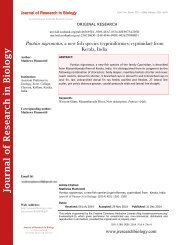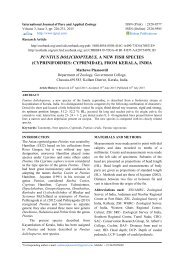You also want an ePaper? Increase the reach of your titles
YUMPU automatically turns print PDFs into web optimized ePapers that Google loves.
International Journal of Fauna and Biological Studies<br />
13827, H.S. Rao; 22.06.1963, 4 examples, 66- 102 mm SL,<br />
Gadhuli Talai, Shergarh, Rajasthan, ZSI/F 4023, SE Rajastan<br />
Survey of ZSI; 30.06.1983, 4 examples, 58.0- 67.5 mm SL,<br />
Talbi, N. of Bimmal Railway station, ZSI/F 4029/2, S. E.<br />
Rajasthan Survey of ZSI.<br />
3.1.8.7. <strong>Puntius</strong> stigma: 10. 02.2010, 5 examples, 72- 86 mm<br />
SL, Trichur, PCMP 35, coll. Mathews Plamoottil.<br />
3.1.8.8. <strong>Puntius</strong> mahecola: 20.01.2011, 7 examples, 70- 87<br />
mm SL, Thiruvalla, PCMP 40, coll. Mathews Plamoottil.<br />
moderately, with 18- 20 fine serrations, its distal end soft and<br />
filamentous. Tip of dorsal reach behind anal origin. Pectorals<br />
inserted on ventro lateral side, tip of it reach pelvic fin origin.<br />
It is triangular and its outer margin nearly straight.<br />
Pectoral fin with one simple and 16 branched rays. Ventral<br />
placed a little in front of dorsal origin, tip of it not reaching<br />
anal fin or vent. Its upper margin is fairly convex; an<br />
elongated and smooth auxiliary scale consisting of two pieces<br />
one above the other, present on either side of ventral. Ventral<br />
fin with one simple and 8 branched rays. Anal fin rectangular;<br />
it is provided with three<br />
3.2. Systomus chryseus, sp. nov.<br />
urn:lsid:zoobank.org:act:DD56462F-7D60-4635-ABC6-<br />
608834CAE1D7<br />
(Figure. 12 & Table 2)<br />
Holotype: ZSI/FF 4625, 150 mm SL, Keezhvaipur, Manimala<br />
River, Kerala, India; collected by Mathews Plamoottil, 01<br />
October 2011.<br />
Paratypes: 4 specimens, ZSI/WGRC/IR/V 2421, 118- 152<br />
mm SL, Keezhvaipur, Manimala River, Kerala, India;<br />
collected by Mathews Plamoottil, 14 May 2012.<br />
3.2.1. Diagnosis: Systomus chryseus can be distinguished from<br />
congeners in having an unusually elongated body, body depth<br />
at dorsal fin origin 25.0- 28.6 in percent of standard length; a<br />
golden to yellowish golden color on flanks; pectoral, pelvic<br />
and anal fins orange red; pectoral fin long and its tip reaches<br />
origin of ventral fin; dorsal fin inserted a little behind ventral<br />
origin and nearer to snout tip than to caudal base; lateral line<br />
scales 29- 30 and pre dorsal scales 11.<br />
3.2.2. Description<br />
General body shape and appearance is shown in Fig. 4.<br />
Morphometric data of holotype and paratypes are provided in<br />
Table 2. Body elongate; dorsal profile from snout to occiput<br />
arched, roughly straight thereafter. Mid dorsal ridge in front of<br />
the dorsal fin origin very narrow, it becomes more wide and<br />
rounded just behind the occiput.<br />
Head moderate; snout round; mouth terminal, forwardly<br />
directed and moderately protrusible; its width greater than<br />
inter narial distance. Eyes bulging above the surface of head<br />
and can be seen from below ventral surface. Orbit diameter<br />
22.5- 28.0 in percent of head length; Nostrils covered by a<br />
membranous lid which originates from the anterior median<br />
side of nares. Inter orbital distance wide, fairly greater than<br />
eye diameter. Nostrils located close to eyes, lid of it touch<br />
front part of eyes. Two pairs of barbels- maxillaries and<br />
rostrals; maxillaries reach behind orbit and nostrils; rostrals<br />
extend to front border of eyes and nostrils.<br />
Dorsal fin inserted above pectoral tip and a little behind<br />
ventral origin, nearer to snout tip than caudal base. Its base<br />
with a row of 6- 8 scales. Upper margin of dorsal fairly<br />
concave; dorsal fin with three simple and 8 branched rays; first<br />
ray of it very small, osseous and moderately hard, second one<br />
longer than the former, osseous and moderately hard. Last<br />
unbranched ray osseous, moderately strong, inner side serrated<br />
Fig 12: A fresh specimen of Systomus chryseus, Holotype, ZSI FF<br />
4625.<br />
simple and 5 branched rays; first anal ray very small and<br />
seemingly absent; second one osseous, smooth and longer than<br />
the former; third ray osseous, smooth and is the longest one.<br />
Sixth anal ray branched to root. Anal fin inserted fairly away<br />
from the ventral tip and a little in front of dorsal fin tip and tip<br />
of it when laid flat not reaching root of caudal fin, but reach<br />
middle of caudal spot. Base of anal with a row of 5 yellow<br />
scales; its outer margin is concave. Caudal fin with 19 rays; its<br />
lobes deeply forked.<br />
Lateral line complete and distinct, slopes gradually down from<br />
the superior margin of opercle to opposite the middle of the<br />
pectoral from where it proceeds direct to centre of the caudal.<br />
Scales comparatively larger, those of the breast region<br />
moderate. Lateral line scales 29-30; pre dorsal scales 11;<br />
scales between lateral line and dorsal fin 5½ - 6½; scales<br />
between lateral line and ventral fin 3½ - 4½; scales between<br />
lateral line and anal fin 4½; circum peduncular scales 7.<br />
3.2.3. Coloration: Fresh specimens. - Lateral sides golden or<br />
yellowish golden; back greenish black; ventral side white;<br />
pectoral, pelvic and anal fins orange red; dorsal fin blackish<br />
green; marginal rays and proximal half of caudal fin blackish<br />
green, distal half reddish; operculum light reddish; a diffuse<br />
black band present behind operculum; a greenish black shade<br />
present at the base of every scales, but it do not appear as<br />
lateral lines on sides. A dark diffused spot present on caudal<br />
base.<br />
Formalin preserved specimens. – Dorsal side greenish; lateral<br />
and ventral sides light yellowish white to hyaline; dorsal and<br />
caudal fins blackish green; pectoral, pelvic and anal fins<br />
hyaline; caudal spot deep black.<br />
3.2.4. Etymology: The <strong>species</strong> name of the <strong>new</strong> fish refers to<br />
its colour; the Latin word “Chryseus” means golden yellow.<br />
~ 140 ~


